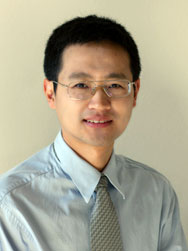【讲座】April 24 (Wed)14:00-16:00pm Development of a Novel Revolving Algal Biofilm Photobioreactor (RABP) for Easy Biomass Harvest
发布日期:2013-04-17
信息来源:
编辑:
Development of a Novel Revolving Algal Biofilm Photobioreactor(RABP) for Easy Biomass Harvest

Zhiyou Wen
Department of Food Science and Human Nutrition
Iowa State University, Ames, Iowa USA 50011
Time: April 24 (Wed)14:00-16:00pm
Location: E118 Meeting Room
Abstract:
Current algal cultivation has been mainly performed in open ponds or closed photobioreactors in which algal cells are suspended in liquid and harvested through sedimentation, filtration, flocculation, and/or centrifugation devices. The objective of this research was to develop a novel attached algal cultivation system to reduce the biomass harvest cost. In the attached growth system, algal cells were attached to a material that was rotating between nutrient-rich liquid phase and carbon dioxide rich gaseous phase for alternative absorption of nutrients and carbon dioxide. The algal cells were harvested by scrapping from the attached surface, and thus, the expensive harvest procedures commonly used in a suspension cultivation system can be avoided.
Compared to the suspended culture systems, the proposed system has several advantages: (i) the biomass can be in-situ harvested DURING the culture process, rather than using an additional sedimentation or centrifugation unit for harvesting (harvested cells have water content similar to that of cells after centrifugation); (ii) the culture enhances the mass transfer by directly contacting algal cells with CO2 molecules in gaseous phase, while traditional suspended culture systems have to rely on the diffusion of CO2 molecules from gaseous phase to the liquid phase which is often limited by low mass transfer rate; (iii) the culture system only needs a small amount of water and land area through utilizing the unique design that only requires the bottom of the reactor system to be bathed in the liquid, this allows for algae cultivation to maximize area by actually growing vertically vs only horizontally.
The attached growth system was optimized for improved biomass productivity. The major operational parameters optimized include biofilm attachment material, harvest duration, rotational speed, and CO2 concentration. It was found that the optimal attachment material was duct cotton, harvest duration of 7 days, rotational speed of 4 rpm and atmospheric CO2 concentration. These parameters resulted in a biomass productivity of 10.5 g∙m-2∙day-1. A compositional analysis (lipid, protein, carbohydrate, ash) was conducted to compare the biofilm based system and standard suspended cultivation system. The compositional analysis showed that algae grown using the attached system has 5% more protein, and 9% more carbohydrate and 14% less lipid, than suspended culture of the same species of algae. The algae grown in the attached growth system produced a higher content of 5 of the 9 essential amino acids, threonine, valine, isoleucine, leucine, phenylalanine, methionine and histidine. Two had no significant difference, while lysine and tryptophan had a lower concentration than the suspended systems. A fatty acid analysis was also conducted but no significant difference was observed. Overall, the results indicated that the attached growth is a promising algal culture system for an improved biomass productivity with high nutritional value.
Bio-Sketch:
Dr. Wen is an associate professor at Food Science and Human Nutrition at Iowa State University and is professor-in-charge of fermentation facility at Iowa State University. His background is chemical and biochemical engineering by training, with research program focusing on developing biological conversion processes for fuels and chemicals production. He has been working different aspect of microalgal cultivation process for fuels and chemicals such as algal fermentation for producing omega-3 polyunsaturated fatty acids; phototrophic algal culture for fuel production. His research on “omega-3 fatty acid production through microalgal fermentation on crude glycerol” has been patented and licensed for commercialization. Dr. Wen is a co-founder and the Chief Science Officer at Algisys, a hybrid Cleantech/Biotech company focused on delivering algal omega-3 fatty acids and high protein additives to the food & beverage, nutraceutical, pharmaceutical, and animal feed industries.